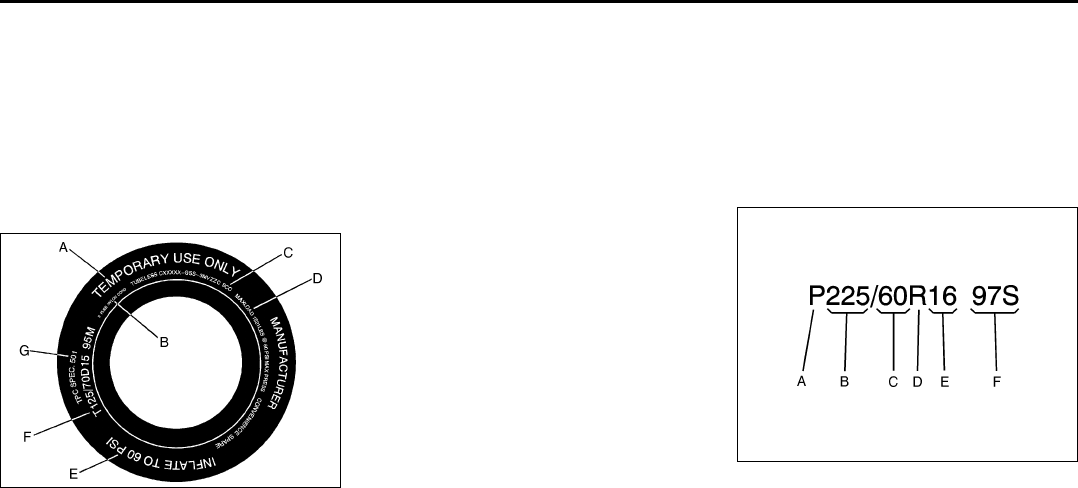
5-27
SERVICE AND APPEARANCE CARE
78J00-03E
grade tires based on three perfor-
mance factors: treadwear, traction,
and temperature resistance. For more
information refer to “Uniform Tire
Quality Grading” in this section.
G. Maximum Cold Inflation Load Limit:
Maximum load that can be carried
and the maximum pressure needed to
support that load.
Compact Spare Tire Example
1376093
A. Temporary Use Only:
The compact spare tire or temporary
use tire has a tread life of approxi-
mately 3000 miles (5000 km) and
should not be driven at speeds over
65 mph (105 km/h). The compact
spare tire is for emergency use when
a regular road tire has lost air and
gone flat. If your vehicle has a com-
pact spare tire, refer to “Compact
Spare Tire” and “If a Tire Goes Flat”
in this section.
B. Tire Ply Material:
The type of cord and number of plies
in the sidewall and under the tread.
C. Tire Identification Number (TIN):
The letters and numbers following the
DOT (Department of Transportation)
code is the Tire Identification Number
(TIN). The TIN shows the manufac-
turer and plant code, tire size, and
date the tire was manufactured. The
TIN is molded onto both sides of the
tire, although only one side may have
the date of manufacture.
D. Maximum Cold Inflation Load Limit:
Maximum load that can be carried
and the maximum pressure needed to
support that load.
E. Tire Inflation:
The temporary use tire or compact
spare tire should be inflated to 60 psi
(420 kPa). For more information on
tire pressure and inflation refer to
“Inflation – Tire Pressure” in this sec-
tion.
F. Tire Size:
A combination of letters and numbers
define a tire’s width, height, aspect
ratio, construction type, and service
description. The letter T as the first
character in the tire size means the
tire is for temporary use only.
G. TPC Spec (Tire Performance Criteria
Specification):
Original equipment tires designed to
SUZUKI’s specific tire performance
criteria have a TPC specification code
molded onto the sidewall. SUZUKI’s
TPC specifications meet or exceed all
federal safety guidelines.
Tire Size
The following illustration shows an exam-
ple of a typical passenger vehicle tire size.
1376101
A. Passenger (P-Metric) Tire:
The United States version of a metric
tire sizing system. The letter P as the
first character in the tire size means a
passenger vehicle tire engineered to
standards set by the U.S. Tire and
Rim Association.
B. Tire Width:
The three-digit number indicates the
tire section width in millimeters from
sidewall to sidewall.


















